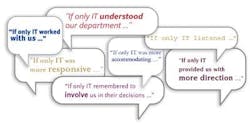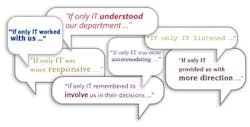The Case for Collaboration
Does this wishful thinking sound a little bit too familiar?
Working with IT can be a struggle, but there’s just no way around it. Every business today - including yours - is dependent on technology. Building tenants and occupants can work without an office, the right desk, appropriate lighting, or an ergonomic chair. But they can’t work without their PCs. Computer applications run your buildings’ systems and support the work of tenants and occupants - and all of that data travels on the IT network through your facility’s walls, floors, and ceilings. IT’s infrastructure is located inside your buildings: Your facility is an envelope around the technology that links your tenants and occupants to their primary businesses. It should be obvious that facilities professionals need to partner with IT to achieve efficiency, productivity, and savings - but many organizations still aren’t making the connection.
Here, we uncover the biggest IT enigmas - one “if only” at a time.
If only IT and FM were managed under the same department ...
“Most likely, IT czars would never agree to become part of an FM [department] ... and vice versa,” says Stormy Friday, founder and president, The Friday Group, Annapolis, MD. Organizations - especially large ones - have reasons for keeping IT and FM separate in terms of administration and supervision. Managing these two departments is a monumental task, and these departments’ goals are different. According to industry professionals, corporations utilizing the Chief Information Officer (CIO) structure often have very specific policies dealing with the delivery of applications, mainframe computing needs, desktop services, etc. The facilities department normally falls under another division simply because job descriptions are so different.
But whether FM and IT are managed by the same person (or department) doesn’t make any difference in terms of the need for teamwork. Whether it’s mandated due to a company’s organizational structure or it occurs out of necessity for delivering services, you can (and should) initiate and maintain a working relationship with IT.
If only IT realized the value that FM brings to the organization ...
IT often considers FM to be an “independent island,” having its own unique requirements which are thought to be irrelevant to the rest of the organization, according to Jerry NeSmith, former president at a Bogart, GA-based IT consulting firm specializing in FM.
But, as NeSmith also points out, “a well-organized IT staff will realize the importance of understanding the workings of FM as a priority equal to understanding and supporting the human resources and accounting departments.” You should be adamant that IT take an interest in FM.
If IT doesn’t understand your value, make it obvious. Regular meetings are a good start - discuss each department’s role within the organization to get a better idea of why both entities are valuable. Friday indicates that the best time for FM and IT to come together is during strategic planning for a specific project.
Many issues are clearly IT’s responsibility (systems, network, applications, etc.). But there are things peripheral to the technology environment that IT depends on (UPS systems, cabling, generators, etc.) which fall under FM’s list of responsibilities. “As a result of the evolution of many IT and building systems, they’re starting to run on the same cabling, talk the same language, interface with each other - it’s forcing IT and FM to come together,” says Steve Falkin, partner at technology consulting firm Baker Robbins & Co., Chicago. “Maybe 90 percent of what [FM and IT] do is distinct, but that 10-percent overlap where they depend on each other and have to work closely with each other will draw them together.”
If only IT would realize that their decisions affect FM ...
If IT doesn’t understand that IT and FM are intertwined, it’s your job to change their perception. Who else is going to?
All too often, FMs are brought in at the eleventh hour. “IT [may be] in the midst of a big initiative to upgrade or implement new systems - and [they realize they need] new conduit installed, or need power, cooling, or space for new equipment, and FM is brought in late in the game,” says Falkin. Most likely, you would’ve been able to offer some insight earlier on in the project. For example: If IT orders new servers, you’ll be able to let them know whether FM does (or doesn’t) have enough resources available to power those servers.
If cable trays aren’t installed correctly, for example, or the capacity of your UPS system isn’t large enough to accommodate IT equipment, guess who’s ultimately to blame? You are - because you haven’t explained your needs or specified the conditions for installation if IT equipment affects the building infrastructure. If IT’s equipment or technology has anything to do with the structure of your facility (mainframe computer rooms, satellite dishes on the roof, fiber optics entering the building, etc.), you should be involved. Things like low-voltage cabling, which both IT and FM use, can share infrastructure, pathways, connection points, etc. to provide cost savings.
Think about it - there are clear efficiencies and economical benefits that result from IT and FM collaboration: “If you can share fiber cabling [with IT], or share a cable pathway, or share a room where equipment and connections [are] ... you can have a much more efficient operation,” says Falkin. “You can save costs on physical space and all the components necessary to pull these systems together. If you combine forces, you can hire the same vendor, contractor, [or] organization to install and maintain these systems, and [achieve] economies in terms of negotiating contracts and prices. Just by working together, getting economies of scale, volume purchasing, and reducing what otherwise might be duplicative space, a lot of potential efficiencies and cost savings come into play.”
Friday indicates that in situations where FM and IT work collaboratively from the beginning, there are always savings in terms of work having to be redone. “[This way,] FM doesn’t move a component and have IT come in after the fact and say, ‘The way you configured that space isn’t going to work for us.’ That happens a great deal if groups work more in serial rather than in parallel.”
With the introduction of the CIO concept, IT is changing and becoming a strategic part of business. IT most likely understands where the organization is headed, and they’re preparing strategic plans to get there. “If they’re doing their jobs, [IT is] thinking 1, 2, or 3-plus years out. It’s good for FM to be in that loop, to be aware of what IT is thinking from a strategic perspective so they can see where technology is going and help prepare the environment (the facility) to meet those changes,” says Falkin.
If only IT would take the initiative to partner with FM on important projects ...
Most likely, IT decisions affect FM more than FM decisions affect IT. And, because of this, IT probably won’t look to partner with FM on their own - according to many professionals, it’s simply “the nature” of IT. You should be prepared to establish that partnership, and drive its success.
Be proactive in your approach. “Say, ‘We see what’s happening in the technology world, we understand how important IT is to the business, and we want to be here to support what you need. We want to be proactive, we want to understand - not just what is happening today or tomorrow, but we want to look at what you’re planning strategically,’ ” says Falkin. Become an active participant in IT - have regular meetings to be aware of their day-to-day issues. Being in the loop will allow you to become part of the “inner workings” of IT. You’ll be in on what’s happening 6 months or 2 years from now, allowing you to make FM decisions that will facilitate IT’s future plans.
“When you’re sitting at the table with an internal customer, identifying requirements for a [project], IT needs to be at that table from Day One,” says Friday. It’s FM’s job to include IT initially - they can’t read minds. Keep them informed throughout the life of the project. IT doesn’t very often think to include FM in their projects, so don’t wait for IT to do it - be proactive and do it yourself.
If only IT showed an interest in something other than wires and networks ...
For the most part, it’s true. IT is only interested, in many cases, in the services they provide - they don’t necessarily care if the customer or end-user (or the FM) is pleased. They’re good at technology ... not at customer relationships. Of course, that’s not a statement that can be used to describe every IT department - according to some, IT is starting to pay more attention to the end-user (your tenants/occupants), but it hasn’t always been their No. 1 goal. That’s not surprising considering that IT training doesn’t typically involve customer relationship management.
As Friday emphasizes, from the customer’s perspective, it’s all the same service. The lines are often blurred between FM and IT. And, ultimately, “the customer doesn’t care who does what. IT and FM need to work together in tandem rather than diametrically opposed to one another, which is often the case. Customers appreciate [hearing] one story, one voice - it doesn’t matter who it comes from, but FM and IT should be on the same page.”
If only FM understood what IT was actually saying ...
As Friday says, “Clients often say they need a third party to do interpretation because FM speaks one language and IT speaks another. When you work together, you’ll find a common language you’re both comfortable with. Then consider how that language will be perceived by the customer, and whether or not the customer will be comfortable with what they’re being told.”
As one FM put it, you can’t sit back and be traditional. You have to be as cognizant of developments in technology as you are in how to choose a better roofing system for your buildings. Technology is constantly changing, so conversations between IT and FM should be constant as well.
It’s okay if you can’t always remember technical terms. But learn to explain yourself well enough for IT to understand what you need. The ability to communicate - regardless of the words you’re using - is critical. Knowing the right terms might help, but you can still get your message across without them. However, NeSmith recommends that if you haven’t worked to develop at least some subject-matter expertise in IT, you should begin to do so before the next IT/FM project.
On the flip side, NeSmith says that IT needs to understand the nature and importance of FM issues as well. If they have the staff resources to do so, IT may want to consider assigning specific people from its team to become experts in FM business procÂÂesses (or vice versa). “While it’s important for FM to understand IT, it’s more important for IT to understand the processes of the FM department,” says NeSmith.
Falkin emphasizes that it’s helpful to be educated to the point of understanding what drives some of IT’s requirements. “A well-educated FM is in a better position to say [to IT], ‘I understand what you’re talking about. I understand why this is necessary, but let’s look at the different options of how, from a facilities perspective, we can support what you’re trying to accomplish. I understand what you want, but I’m also serving six other departments in our company. Let me try to tie in their requirements with what you’re saying, so maybe we can buy that [piece of equipment] once, or buy it a little bit bigger, or do something that gets everyone what they need instead of doing things independently.’ ”
Leah B. Garris ([email protected]) is associate editor at Buildings magazine.

